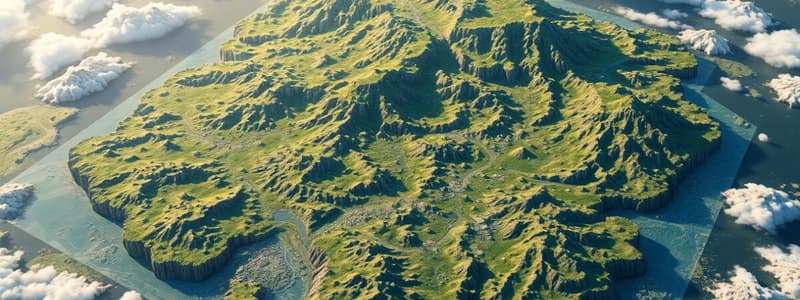Podcast
Questions and Answers
What is the primary focus of the buffering algorithm discussed?
What is the primary focus of the buffering algorithm discussed?
- Creating polygon surfaces only
- Analytical operations for 2D maps
- Point features in 3D GIS (correct)
- Computational physics
The buffering algorithm is constrained to a single XY plane.
The buffering algorithm is constrained to a single XY plane.
False (B)
What geometric shape does the buffering operation evolve into?
What geometric shape does the buffering operation evolve into?
sphere
The system for handling spatial objects should not be constrained by a single ________ only.
The system for handling spatial objects should not be constrained by a single ________ only.
Match the sections with their focus:
Match the sections with their focus:
What is one key focus area of the paper?
What is one key focus area of the paper?
Which of the following best describes a Geographic Information System (GIS)?
Which of the following best describes a Geographic Information System (GIS)?
The paper states that most GIS systems currently offer robust 3D analytical operations.
The paper states that most GIS systems currently offer robust 3D analytical operations.
Buffering operations in GIS can only be performed in 2D space.
Buffering operations in GIS can only be performed in 2D space.
Name an analytical tool discussed in the paper that should be included in a 3D GIS system.
Name an analytical tool discussed in the paper that should be included in a 3D GIS system.
What are the three types of buffering tools developed for terrain spatial objects?
What are the three types of buffering tools developed for terrain spatial objects?
Geographic information systems now handle both two-dimensional and __________ data.
Geographic information systems now handle both two-dimensional and __________ data.
GIS systems face difficulties in handling _____ datasets, particularly those that involve 3D analysis.
GIS systems face difficulties in handling _____ datasets, particularly those that involve 3D analysis.
Match the following aspects of the 3D buffering with their descriptions:
Match the following aspects of the 3D buffering with their descriptions:
Which department is associated with the development of 3D analytical tools according to the authors?
Which department is associated with the development of 3D analytical tools according to the authors?
Match the following features with their corresponding definitions:
Match the following features with their corresponding definitions:
The authors tested their 3D buffering approach using hand-drawn datasets.
The authors tested their 3D buffering approach using hand-drawn datasets.
Which of the following applications can benefit from 3D analytical GIS operations?
Which of the following applications can benefit from 3D analytical GIS operations?
Name one typical analytical GIS operation that can be conducted on point objects.
Name one typical analytical GIS operation that can be conducted on point objects.
What future development does the paper propose to focus on within the 3D GIS domain?
What future development does the paper propose to focus on within the 3D GIS domain?
Geographic information system tools are useful only for GIS specialists.
Geographic information system tools are useful only for GIS specialists.
Flashcards are hidden until you start studying
Study Notes
3D Analytical Tools for Terrain Spatial Objects
- Geographic Information Systems (GIS) are evolving to manage 3D and 4D spatial data beyond traditional 2D data.
- Current GIS platforms primarily emphasize visualization rather than comprehensive 3D analytical capabilities.
- Buffering is identified as a critical analytical tool in 3D GIS systems to understand spatial relationships.
Development of 3D Buffering Algorithms
- The paper outlines the development of analytical tools specifically for terrain spatial objects.
- Key 3D buffering techniques include:
- Point buffering
- Line buffering
- Polygon buffering
- Results from these buffering methods can be visualized using software applications like ArcView.
Point Buffering
- Points are represented as coordinate triplets (x, y, z) and can symbolize various point features including:
- Boreholes
- Control towers
- Survey points along power lines
- Natural features like ponds and lakes, as well as underground bodies like ore deposits.
- Point buffering operations utilize spherical geometry, where the point expands into a gradient sphere based on a defined radius.
Importance of 3D Analysis
- Traditional 2D GIS does not adequately represent spatial phenomena as perceived in the real world; thus, 3D analysis is essential for accurate understanding.
- 3D analysis is vital for various applications including environmental monitoring, urban planning, geological exploration, and navigation.
Goals for Advanced 3D Solutions
- The paper includes a forward-looking framework toward the advancement of analytical solutions in the 3D GIS domain.
- An improved understanding of spatial phenomena can be achieved through effective 3D buffering techniques and algorithms.
Studying That Suits You
Use AI to generate personalized quizzes and flashcards to suit your learning preferences.




